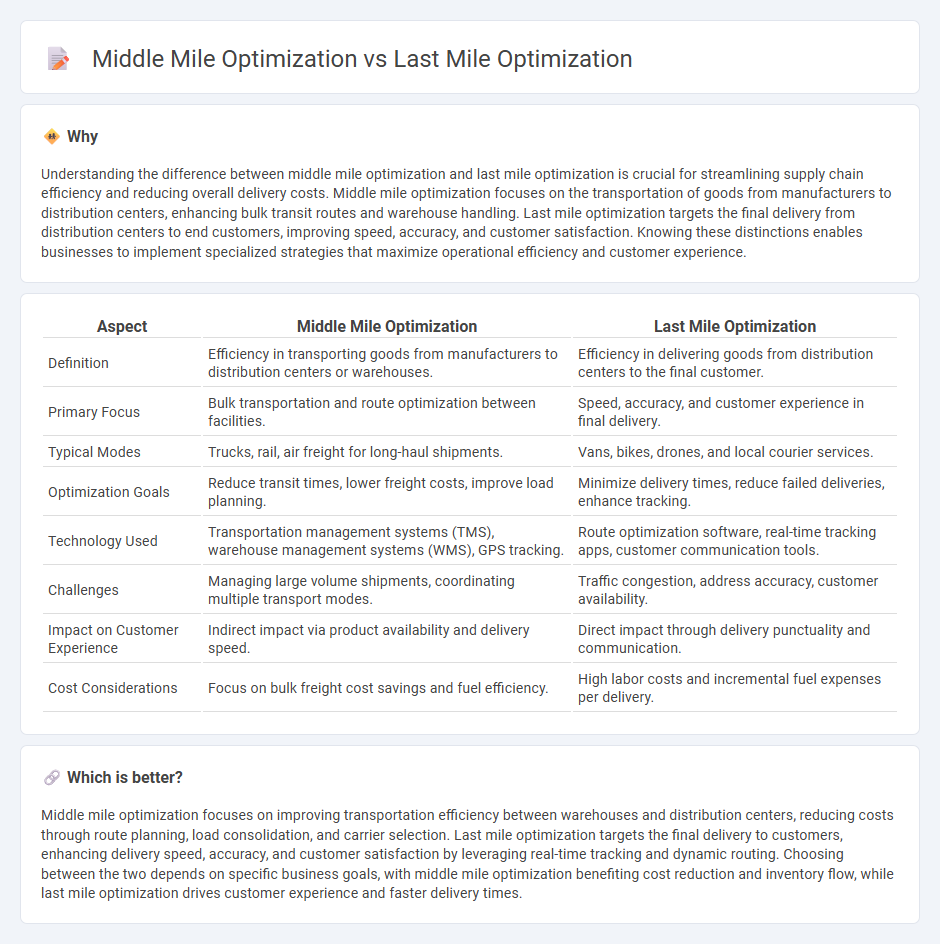
Middle mile optimization focuses on streamlining the transportation of goods from warehouses to distribution centers, enhancing efficiency in bulk movement and reducing transit time. Last mile optimization targets the final delivery leg to customers, prioritizing speed, accuracy, and cost-effectiveness to improve customer satisfaction. Explore the differences and strategies behind these critical logistics phases to boost your supply chain performance.
Why it is important
Understanding the difference between middle mile optimization and last mile optimization is crucial for streamlining supply chain efficiency and reducing overall delivery costs. Middle mile optimization focuses on the transportation of goods from manufacturers to distribution centers, enhancing bulk transit routes and warehouse handling. Last mile optimization targets the final delivery from distribution centers to end customers, improving speed, accuracy, and customer satisfaction. Knowing these distinctions enables businesses to implement specialized strategies that maximize operational efficiency and customer experience.
Comparison Table
| Aspect | Middle Mile Optimization | Last Mile Optimization |
|---|---|---|
| Definition | Efficiency in transporting goods from manufacturers to distribution centers or warehouses. | Efficiency in delivering goods from distribution centers to the final customer. |
| Primary Focus | Bulk transportation and route optimization between facilities. | Speed, accuracy, and customer experience in final delivery. |
| Typical Modes | Trucks, rail, air freight for long-haul shipments. | Vans, bikes, drones, and local courier services. |
| Optimization Goals | Reduce transit times, lower freight costs, improve load planning. | Minimize delivery times, reduce failed deliveries, enhance tracking. |
| Technology Used | Transportation management systems (TMS), warehouse management systems (WMS), GPS tracking. | Route optimization software, real-time tracking apps, customer communication tools. |
| Challenges | Managing large volume shipments, coordinating multiple transport modes. | Traffic congestion, address accuracy, customer availability. |
| Impact on Customer Experience | Indirect impact via product availability and delivery speed. | Direct impact through delivery punctuality and communication. |
| Cost Considerations | Focus on bulk freight cost savings and fuel efficiency. | High labor costs and incremental fuel expenses per delivery. |
Which is better?
Middle mile optimization focuses on improving transportation efficiency between warehouses and distribution centers, reducing costs through route planning, load consolidation, and carrier selection. Last mile optimization targets the final delivery to customers, enhancing delivery speed, accuracy, and customer satisfaction by leveraging real-time tracking and dynamic routing. Choosing between the two depends on specific business goals, with middle mile optimization benefiting cost reduction and inventory flow, while last mile optimization drives customer experience and faster delivery times.
Connection
Middle mile optimization streamlines the transportation of goods between warehouses and distribution centers, reducing transit times and costs, which directly impacts last mile delivery efficiency. By improving inventory positioning and load consolidation in the middle mile, companies can ensure faster, more reliable last mile fulfillment, enhancing customer satisfaction. Effective integration of both stages leads to a cohesive supply chain that minimizes delays and maximizes resource utilization.
Key Terms
**Last Mile Optimization:**
Last mile optimization enhances delivery efficiency by reducing transit times and costs while improving customer satisfaction through precise route planning and real-time tracking. It leverages advanced technologies like AI-driven analytics and IoT devices to manage last mile logistics, ensuring faster, more reliable deliveries to end consumers. Explore further to understand how last mile optimization transforms supply chains and boosts competitive advantage.
Route Planning
Last mile optimization concentrates on refining route planning to ensure faster, more efficient deliveries directly to the customer's doorstep, often dealing with unpredictable traffic and multiple stops. Middle mile optimization focuses on streamlining the transportation of goods between warehouses or distribution centers, aiming for bulk efficiency and reduced transit time on primary routes. Explore detailed strategies to enhance both last mile and middle mile route planning for superior supply chain performance.
Delivery Windows
Last mile optimization enhances delivery windows by reducing transit times and improving route accuracy, ensuring timely arrivals at the customer's doorstep. Middle mile optimization focuses on the efficient movement of goods between distribution centers, impacting delivery windows indirectly through improved inventory availability and reduced delays. Explore our comprehensive guide to understand how optimizing both segments can streamline your supply chain operations.
Source and External Links
Last Mile Delivery Optimization Strategies for 2025 - WorkWave - Last mile optimization involves dynamic route optimization using real-time data and sophisticated algorithms to reduce delivery times, fuel consumption, and costs while enhancing sustainability.
Maximizing Last Mile Success: The Power of Network Optimization - Effective last mile optimization includes strategic location planning for distribution centers, multi-modal transportation, advanced routing algorithms, collaborative partnerships, and technology integration to improve speed, cost, and service quality.
Last mile strategy: 5 Ways to improve last mile delivery ... - FarEye - Key last mile optimization strategies include understanding customer needs, using AI/ML-powered route planning software for efficient delivery, and integrating real-time tracking to increase visibility and proactive decision-making.
 dowidth.com
dowidth.com